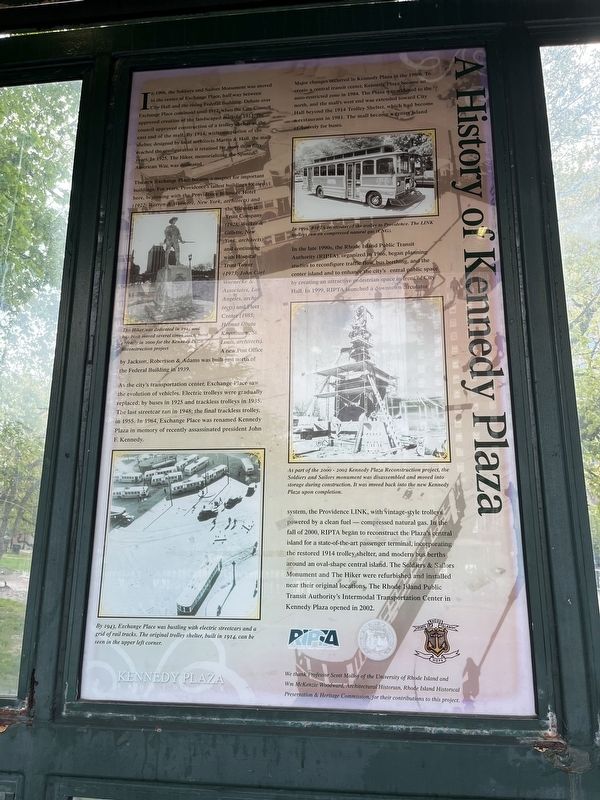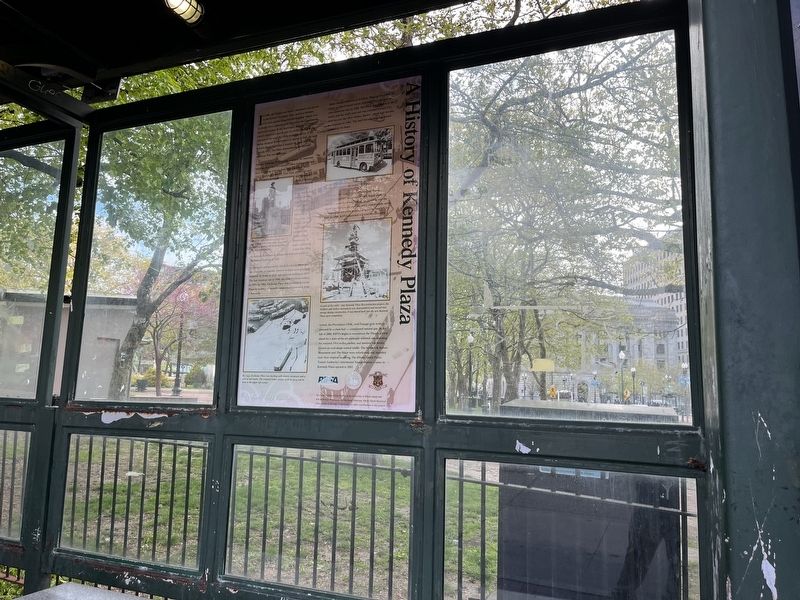Downtown Providence in Providence County, Rhode Island — The American Northeast (New England)
A History of Kennedy Plaza
Kennedy Plaza
— Providence —
In 1906, the Soldiers and Sailors Monument was moved to the center of Exchange Place, half way between City Hall and the rising Federal Building. Debate over Exchange Place continued until 1912, when the City Council approved creation of the landscaped mall. In 1913, the council approved construction of a trolley shelter at the east end of the mall. By 1914, with completion of the shelter, designed by local architects Martin & Hall, the mall reached the configuration it retained for more than fifty years. In 1925, The Hiker, memorializing the Spanish American War, was dedicated.
The new Exchange Place became a magnet for important buildings. For years, Providence's tallest buildings located here, beginning with the Providence Biltmore Hotel (1922; Warren & Wetmore, New York, architects) and the Industrial Trust Company (1928; Walker & Gillette, New York, architects) and continuing with Hospital Trust Tower (1973; John Carl Warnecke & Associates, Los Angeles, architects) and Fleet Center (1985; Helmut Obata Kassabuam, St. Louis, architects). A new Post Office by Jackson, Robertson & Adams was built just north of the Federal Building in 1939.
As the city's transportation center, Exchange Place saw the evolution of vehicles. Electric trolleys were gradually replaced: by buses in 1925 and trackless trolleys in 1935. The last streetcar ran in 1948; the final trackless trolley, in 1955. In 1964, Exchange Place was renamed Kennedy Plaza in memory of recently assassinated president John F. Kennedy.
Major changes occurred in Kennedy Plaza in the 1980s. To create a central transit center, Kennedy Plaza became an auto-restricted zone in 1984. The Plaza was widened to the north, and the mall's west end was extended toward City Hall beyond the 1914 Trolley Shelter, which had become a restaurant in 1981. The mall became a center island exclusively for buses.
In the late 1990s, the Rhode Island Public Transit Authority (RIPTA), organized in 1966, began planning studies to reconfigure traffic flow, bus berthing, and the center island and to exchange the city's entral public space by creating an attractive pedestrian space in front of City Hall. In 1999, RIPTA launched a downtown circulator system, the Providence LINK, with vintage-style trolleys powered by a clean fuel - compressed natural gas. In the fall of 2000, RIPTA began to reconstruct the Plaza's central island for a state-of-the-art passenger terminal, incorporating the restored 1914 trolley shelter, and modern bus berths around an oval-shape central island. The Soldiers & Sailors Monument and The Hiker were refurbished and installed near their original locations. The Rhode Island
We thank Professor Scott Molloy of the University of Rhode Island and Wm McKenzie Woodward, Architectural Historian, Rhode Island Historical Preservation & Heritage Commission, for their contributions to this project.
[Captions:]
The Hiker was dedicated in 1925 and has been moved several times since, most recently in 2000 for the Kennedy Plaza Reconstruction Plaza.
By 1943, Exchange Plaza was bustling with electric streetcars and a grid of rail tracks. The original trolley shelter, built in 1914, can be seen in the upper left corner.
In 1999, RIPTA reintroduced the trolley to Providence. The LINK trolleys run on compressed natural gas (CNG).
As part of the 2000 - 2002 Kennedy Plaza Reconstruction project the Soldiers and Sailors monument was disassembled and moved into storage during construction. It was moved back into the new Kennedy Plaza upon completion.
Erected by Rhode Island Public Transit Authority (RIPTA); The City of Providence; State of Rhode Island.
Topics. This historical marker is listed in these topic lists: Architecture • Arts, Letters, Music • Parks & Recreational Areas • Railroads & Streetcars • Roads & Vehicles. A significant historical year for this entry is 1906.
Location. 41° 49.506′ N, 71° 24.743′ W. Marker is in Providence, Rhode Island, in Providence County. It is in Downtown Providence. Marker can be reached from Washington Street east of Dorrance Street, on the left when traveling east. Touch for map. Marker is at or near this postal address: 31 Washington St, Providence RI 02903, United States of America. Touch for directions.
Other nearby markers. At least 8 other markers are within walking distance of this marker. A different marker also named A History of Kennedy Plaza (here, next to this marker); a different marker also named A History of Kennedy Plaza (here, next to this marker); Providence Harbor History (within shouting distance of this marker); Rhode Island Soldiers and Sailors Memorial (within shouting distance of this marker); Civil War Monument (within shouting distance of this marker); Union Station (about 300 feet away, measured in a direct line); The Hiker (about 300 feet away); Ambrose Burnside Memorial (about 400 feet away). Touch for a list and map of all markers in Providence.
Credits. This page was last revised on May 9, 2023. It was originally submitted on May 9, 2023, by Devry Becker Jones of Washington, District of Columbia. This page has been viewed 78 times since then and 26 times this year. Photos: 1, 2. submitted on May 9, 2023, by Devry Becker Jones of Washington, District of Columbia.

